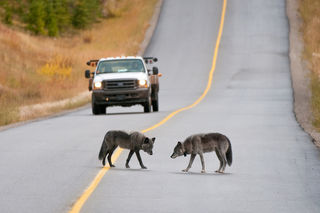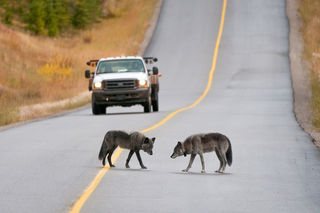
The well-known Bow Valley wolf pack is down to two animals after one wandered hundreds of kilometres into British Columbia where it was shot by a hunter in March.
The two-year-old male, known as 1502, had recently been fitted with a new GPS collar in Banff National Park on March 15. Days later he began a westward trek that ended near Arrow Lakes, B.C., on March 31. The hunter turned the collar in to conservation officials, but parks officials already suspected the worst as GPS data showed no movement.
The Bow Valley pack, which once numbered as high as nine, now consists of an alpha male and his female offspring. Six members of the pack died last year: four pups were killed by trains and two females, including the alpha, had to be destroyed after becoming aggressive looking for food in campgrounds.
“Certainly it’s concerning that so many members of this pack have been killed in recent months,” said Aerin Jacob, wildlife scientist for the Yellowstone to Yukon Conservation Initiative (Y2Y). “All instances of human-wildlife conflict are concerning for both people and animals, but especially when it’s carnivores.”
A longtime wolf researcher who is very familiar with the pack is saddened but not surprised by the outcome.
“It’s unfortunate, but the situation for wolves in the park is very tenuous in terms of long-term survival,” said Paul Paquet, adjunct professor at the University of Victoria who has studied wolf ecology behaviour for 45 years. “This just adds to the difficulties the pack is already facing in trying to survive in the Bow Valley.”
Paquet puts some blame on increasing development in the national park, which has pushed wildlife out of traditional habitat.
“The sad story is that it’s a legacy of decisions that have been made over the years that favoured development over wolves. It’s undeniable. It’s not a criticism of the decisions — or the people who made them — it’s just a fact,” said Paquet, who oversaw the most extensive wolf research project in North America in the late 1980s and who is a senior scientist with Raincoast Conservation.
“It’s important that people realize what’s happening is not maliciously done.”
Parks Canada officials declined to be interviewed, instead emailing a statement declaring its commitment to both land and species, while also developing services for Canadians.
“Parks Canada is mandated to maintain or restore ecological integrity, and provide Canadians with opportunities to discover and enjoy them. Parks Canada is a recognized world leader in conservation and has been successfully balancing this integrated mandate for over 100 years.
“It should be noted that strict development limits are in place to protect the ecological integrity of national parks. Parks Canada remains committed to a rigorous development review and environmental assessment process that ensures all development proposals comply with these limits and that a park’s ecological integrity is maintained.”
Jacob said the most recent wolf death highlights the need to preserve large tracts of land. Some individual wolves have been known to travel hundreds of kilometres, such as a collared female named Pluie who roamed an area of 100,000 square kilometres between 1991 and 1993.
“There is a silver lining to the story. Wolf 1502 travelled over a huge area, including along important habitat corridors and in protected and unprotected areas. It shows that we need to think about animal movement over really large scales — bigger than most people think — and that corridors work.”
Paquet is not giving up hope the Bow Valley pack can survive this latest setback. Twice before, in the 1920s and ‘50s, wolves in the park were pushed to the brink. In fact, no wolves remained after being hunted, trapped and poisoned. He said it’s quite possible this pack will re-establish if the father and daughter mate.
“My guess is they’ll try to form their own pack. We’ll probably know very soon (if there are pups).”
The other possibility is the two could try to join other packs, such as the Fairholme or the Panther Cascade, which roam deeper in Alberta’s backcountry, or they could disperse farther afield as No. 1502 might have been doing when shot.
When the wolf left the Bow Valley in mid-March, he headed west from Castle Junction toward Lake Louise, through Yoho National Park to Golden. He wandered over to Glacier National Park before heading straight south to Argenta. There he went west to New Denver, where he turned northwest and travelled up Arrow Lakes to a point near Camborne, where he was killed.
“It’s a tough life out there,” said Paquet. “But sometimes it’s tougher inside the park. There’s a real irony there.”
According to Jesse Whittington, wildlife ecologist with Banff National Park, the Bow Valley pack has been travelling more and more into the backcountry and predating naturally on deer, elk and moose, which is encouraging.
“Typically, late winter is the best time for wolves,” he said. “We’re hopeful that the wolves are in really good shape right now, and that will set them up with success through the summer.”
Whittington said the remaining wolves in the pack are GPS collared and will continue to be monitored regularly.
Source: Legacy of decisions blamed for wolves’ demise | The Crag and Canyon

Comments
“He said it’s quite possible this pack will re-establish if the father and daughter mate.” This is a “silver lining”??? Inbreeding starts the beginning of the end of a wolf pack. All the deaths of this pack were due to humans. All the more reason to stop hunting these animals. They don’t need to be hunted to control their population.